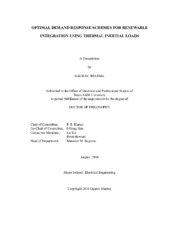| dc.description.abstract | We consider a smart microgrid environment where renewable power sources like wind generators are available to service the thermal inertial load along with conventional non-renewable energy sources. The flexibility in power consumption of thermal inertial loads, like air-conditioners can be used towards absorbing the fluctuations in intermittently available renewable power sources. Several optimization schemes can be used towards this goal. We discuss and analyze some of these optimization models. An optimization model which promotes renewable consumption by penalizing non-renewable consumption, but does not account for variations in the load requirements, lead to an optimal solution in which all the loads’ temperatures behave in a lockstep fashion. That is, the power is allocated in such a fashion that all the temperatures are brought to a common value and they are kept the same after that time, resulting in synchronization among all the loads. We show that under a model which additionally penalizes the comfort range violation, the optimal solution is in fact of a de-synchronizing nature, where the temperatures are intentionally kept apart to avoid power surges resulting from simultaneous comfort violation across many loads.
In the sequel, we additionally take into account several other factors, such as the privacy requirements from the users of loads, architectural simplicity, and tractability of the solution. We propose a demand response architecture where no information from the end-user is required to be transferred in order to optimally co-ordinate their power consumption. We propose a simple threshold value based policy which is architecturally simple, computationally inexpensive, and achieves optimal staggering among loads to smooth the variations in non-renewable power requirements. We show that it is possible to compute the optimal solution in a number of scenarios, and give a heuristic approach to approximate the optimal solution for the scenarios where information such as cooling/heating rates, etc. is not available. | en |


